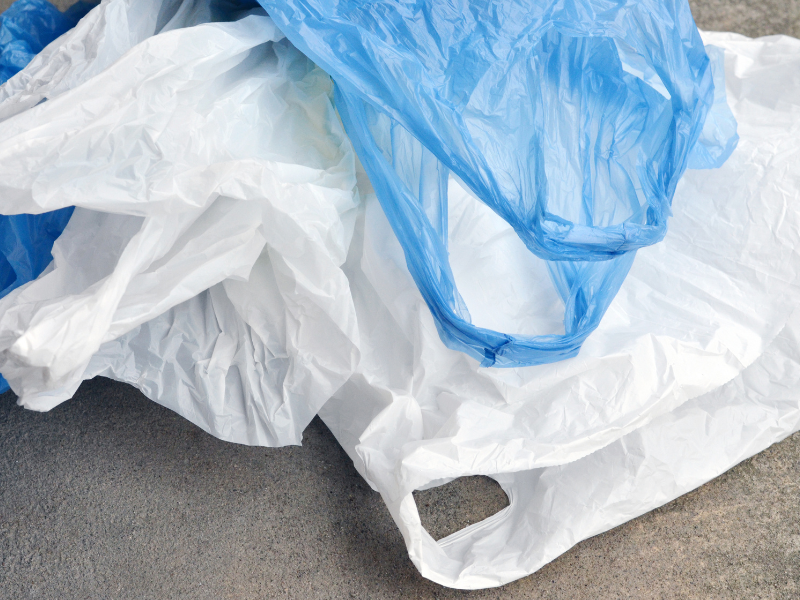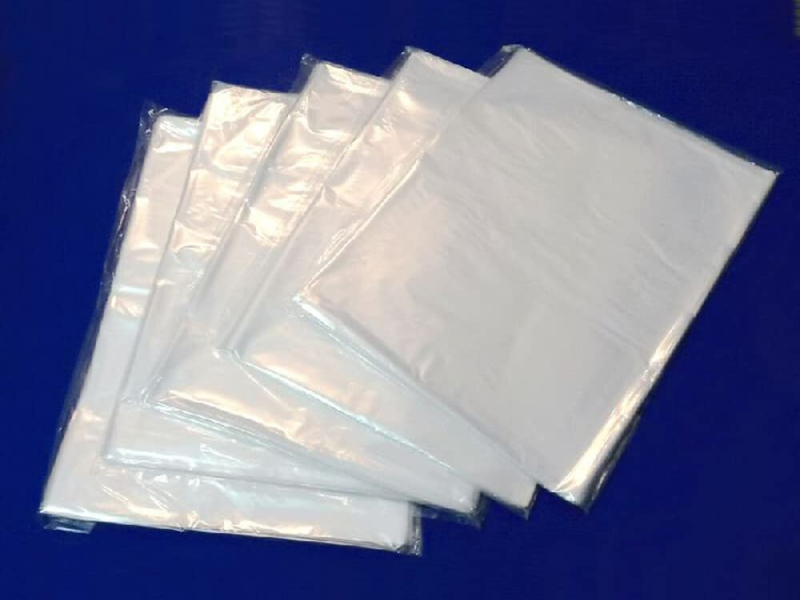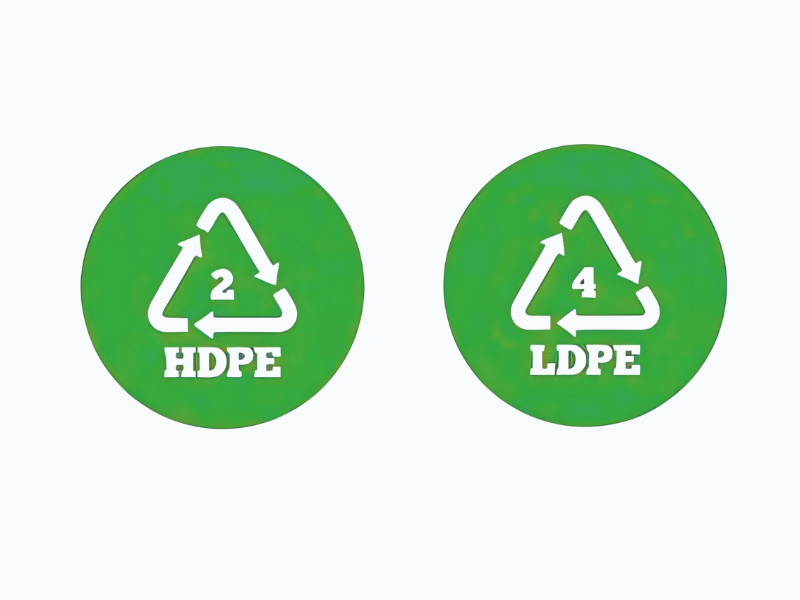.png)
Plastic bags made from polyethylene are everywhere—from grocery stores to industrial packaging. The two most common types are HDPE (High-Density Polyethylene) and LDPE (Low-Density Polyethylene). While they may look similar, their properties, applications, and environmental impacts are quite different. Choosing the right type of bag can save costs, improve performance, and reduce waste. Eco Plastic will help you understand the differences between HDPE vs LDPE bags in detail.
1. HDPE vs LDPE: Definitions and Key Characteristics
1.1 What is HDPE?
High-Density Polyethylene (HDPE) is a thermoplastic polymer made from petroleum. It has a tightly packed molecular structure with minimal branching, which increases its density. This results in a plastic that is tough, rigid, and resistant to impact and heat.
HDPE is commonly used for products that need durability—think grocery checkout bags, garbage bags for heavy loads, industrial packaging, milk jugs, and even outdoor piping. Despite being thin, HDPE bags can handle surprisingly heavy weights without tearing.

What is HDPE?
1.2 What is LDPE?
Low-Density Polyethylene (LDPE), on the other hand, has a highly branched molecular structure. This looser arrangement lowers the density, creating a plastic that is soft, flexible, and transparent.
LDPE is widely used in applications where stretchability and clarity matter more than strength. Examples include food wraps, bread bags, bubble wrap, and zip-lock bags. LDPE’s ability to stretch without breaking makes it ideal for packaging products that need cushioning or sealing.

What is LDPE?
1.3 Key Difference in a Nutshell
- HDPE = stronger, stiffer, more durable
- LDPE = softer, clearer, more flexible
2. Physical and Mechanical Properties
The easiest way to understand the difference is by looking at their performance in real-life scenarios.
|
Property |
HDPE Bags | LDPE Bags |
| Density | 0.941–0.965 g/cm³ → tighter structure, stronger | 0.910–0.940 g/cm³ → lighter, softer |
| Tensile Strength | Excellent tensile strength, highly tear-resistant | Lower tensile strength, stretches under weight |
| Flexibility | Rigid, holds shape | Soft, bendable, stretchable |
| Appearance | Opaque to translucent | Clearer, semi-transparent |
| Heat Resistance | Higher (120–180°C), heat resistant | Lower (105–115°C), less heat resistant |
| Impact Resistance | Strong resistance to punctures and stress | Absorbs shock with elasticity, but weaker against sharp punctures |
| Thickness in Bags | Works well for thinner yet strong bags | Requires thicker film for strength |
Example in daily life:
When you carry groceries with heavy bottles or canned goods, the thin crinkly plastic bag is usually HDPE. When you place fruits or vegetables in a lightweight, clear bag from the produce section, that’s almost always LDPE.
This structural difference also explains why HDPE feels “crinkly” and noisy, while LDPE feels soft and smooth.
3. Applications of HDPE vs LDPE Bags
3.1 HDPE Bag Applications
HDPE’s strength and chemical resistance make it suitable for:
- Grocery store checkout bags
- Heavy-duty garbage bags
- Industrial packaging for chemicals and powders
- Milk jugs and detergent bottles
- Outdoor piping and containers exposed to heat
3.2 LDPE Bag Applications
LDPE’s softness and stretch make it ideal for:
- Produce bags and bread bags
- Clear retail packaging for display
- Zip-lock and resealable storage bags
- Food wraps and bubble wrap
- Protective film and stretch wrap for shipping
4. Advantages and Disadvantages of Each Material
Every material comes with benefits and trade-offs.
4.1 HDPE Advantages
- Very strong and durable even in thin films
- Resistant to chemicals and moisture
- Performs well in hot or outdoor environments
- Lightweight yet capable of carrying heavy loads
4.2 HDPE Disadvantages
- Less flexible and more rigid
- Opaque, limiting its use in product display
- Can crack under repeated bending stress
4.3 LDPE Advantages
- Soft, flexible, and easy to handle
- Offers good transparency for showcasing products
- Ideal for sealing and stretching applications
- Resists impact by stretching instead of tearing
4.4 LDPE Disadvantages
- Weaker tensile strength compared to HDPE
- More prone to punctures from sharp objects
- Lower heat and UV resistance
- Requires thicker film for heavy-duty applications
5. Environmental Impact and Recycling
The question of sustainability often arises when comparing HDPE vs LDPE.
5.1 Recycling Codes
- HDPE = #2 on recycling labels
- LDPE = #4 on recycling labels
5.2 Recyclability
- HDPE: Widely recyclable. It can be turned into new bottles, containers, pipes, or even new bags. Its higher recycling rate makes it a more eco-friendly choice.
- LDPE: Technically recyclable, but not always accepted in curbside programs. Thin LDPE films can clog recycling machinery, which is why specialized drop-off locations are often required. When recycled, LDPE can be made into garbage can liners, floor tiles, or shipping envelopes.
6. Environmental Considerations
Both HDPE and LDPE are derived from fossil fuels, which raises concerns about carbon footprint. However, because HDPE is more commonly recycled, it generally has a smaller environmental impact in practice.
Still, the most sustainable choice is to reduce single-use plastics altogether—by reusing bags, switching to compostable materials, or supporting circular recycling systems.

Environmental Considerations
7. How to Choose the Right Bag: HDPE or LDPE?
When selecting bags for your business or personal use, consider these factors:
7.1 Weight of Items
- Heavy items → HDPE
- Light or soft items → LDPE
7.2 Flexibility Needs
- Need for stretch or sealing → LDPE
- Need for strength and rigidity → HDPE
7.3 Temperature Conditions
- Exposure to heat or outdoor environments → HDPE
- Indoor, cooler storage → LDPE
7.4 Clarity and Presentation
- For retail display → LDPE
- For heavy-duty use where clarity doesn’t matter → HDPE
7.5 Recycling Options
- If local recycling programs favor HDPE, choose it for sustainability.
Conclusion
Through this article, you’ve learned the key differences between HDPE and LDPE bags—from their structure and strength to their applications, recyclability, and environmental impact. While HDPE stands out for its durability and recycling potential, LDPE remains essential for flexibility and clarity. Each has its place depending on the specific needs of your business or daily life. If you’re looking for the right plastic bag solution that balances performance and sustainability, Eco Plastic is here to provide expert guidance and high-quality products tailored to your needs.














